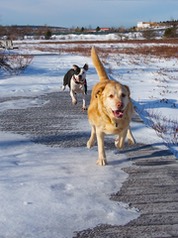A couple of months ago I was approached by Pamela Pardy Ghent of the Newfoundland Herald to write a piece on a subject of my choosing. At the time there was much discussion in the media surrounding a pit bull that mauled and killed a tethered beagle. Once again there was a cry to ban all pit bulls with “experts” coming out of the woodwork warning people of the inherent dangers pit bulls present. These experts quoted “facts” and once again, the “facts” were accepted by many as absolute truths.
This section of my site was born in response to that.
Below is the article I submitted and was published. I am printing it here to share with those who did not see it. The citations used in the article can be found in Pit Bull Fun Fact Day Six. Those articles along with their associated bibiographies make for some great reading and I encourage anybody to use them in your discussions. Combat fear with fact, replace misinformation with education…the resulting discussion will be much more beneficial to all involved.
The Truth About Pit Bulls (published September 4-10, 2016)

This summer, the media was aflutter with news that a pit bull mauled a woman in Quebec. The report met with widespread outrage. Immediate action was demanded by the public. Various municipalities in Quebec discussed enacting breed specific legislation (bsl) calling for a ban on pit bulls. The safety of the public was at stake. Questionable bite statistic reports were haphazardly repeated as gospel and legislation was drawn up to bring bring an end to pit bulls in Quebec.
It was a sad time. Pit bull owners had to watch as their dogs were vilified once again. Outrage led to a knee jerk reaction rooted in fear. Unfortunately when we humans fear something, our first response is often to eradicate it. It does not matter if the fears are valid or not. It does not matter if the fears are backed by science. Quantifiable proof be damned. Full steam ahead toward that iceberg!!!
Pit bulls are not the bogeymen of the dog world. Most of what the general public repeat about them as fact is, in reality, a myth. There is nothing special about them as a breed. Certainly no prevalent characteristic which should incite the level of fear it does among the public. For that matter, in North America, pit bulls are not even really recognized as an actual breed. They are more so a grouping of dogs sharing similar characteristics.

Let’s put a couple of those myths to rest.
Pit bulls do not have locking jaws. Biologically, their jaws are no different than any other dog. They do have tremendous power in their jaws but they are outclassed in terms of biting power by many breeds. The power in a dog’s jaws depends much on the size of the dog. This differs considerably from individual to individual especially within the pit family where you can have dogs weighing as little as 20 pounds to dogs weighing 120 pounds plus, biting power is no more a characteristic of pit bulls than any other dog (Duffy et al, 2008).
Pit bulls do not have a gene which predisposes them to be aggressive. Actually, the pit bull continuously scores higher in standardized temperament testing than many breeds (Sacks et al, 1996). What this means is that while they can bite, they are less likely to do so than most dogs.
It is true, pit bulls comprise only a small percentage of the dog population in many areas but account for a large percentage of the reported dog attacks. However, these often quoted statistics can be very misleading (Centers For Disease Control and Prevention, 2000). Actual reputable studies show that when follow up was done on reported attacks, in many cases the dog was misidentified as a pit bull (American Veterinary Medical Association, 2001). Furthermore, the number of actual pit bulls in any given area could not be identified with any accuracy and there were other, more important factors than breed which contributed to the attack (National Canine Research Council, 2016).
I say, actual reputable studies because there is not one peer reviewed research study done by any reputable group published in a respected scientific journal that shows breed is a reliable predictor in identifying aggression. On the flip side, there is a wealth of published studies from very reputable organizations which show breed specific legislation does not work. Animal welfare organizations like the American Society for the Protection of Animals, the American Humane Society, and the National Canine Research Council have all released position statements backed by extensive scientific research objecting to BSL. Groups such as the American Veterinary Medical Association and the Centre for Disease Control have performed some of the largest most exhaustive studies on the issue. All have stated clearly that breed is a poor indicator of aggression, that BSL does not work and warn people of the misleading nature of using bite statistics.
Even the White House stated that:
“We (the White House) don't support breed-specific legislation -- research shows that bans on certain types of dogs are largely ineffective and often a waste of public resources.” (Obama, 2013)
The scientific community has spoken quite emphatically. Breed specific discussion is a useless endeavour. Not only is it ineffective, but it is dangerous. It leads to a false sense of security of both the public and our elected officials. It creates an illusion of public safety which is not based in reality. It is, in effect, a placebo and a dangerous one at that.

Frankly, we the public, deserve better.
There are other factors which can enhance public safety and lead to an actual decrease in dog attacks (NACA, 2014). Laws which focus on responsible pet ownership, breed neutral dangerous dog legislation, and anti chaining legislation are a good start. Programs focused on public education, and dog classes which promote early proper and extensive socialization would help. Responsible pet ownership practices combined with legislation that focuses on individual dogs and owners would go much further in addressing public safety concerns than any enactment of breed specific legislation (AMVA, 2014).
So let’s put the focus where it is shown to be beneficial instead of chasing futile efforts.
As for the “pit bull attack” in Quebec which precipitated the discussion, there were some interesting developments which occurred. A panel of professionals was tasked to study the issue and provide the government with advice. A report from the panel was leaked which recommended against the the ban of pit bulls and instead advised the government to implement regulations involving responsible pet ownership measures. The Quebec Order of Veterinarians participated in the panel and cited extensive research showing breed specific legislation does not work. Despite this, the Minister of Health, Gaetan Barrette has stated that BSL is not off the table as it is his opinion that “the risk with these dogs (pit bulls) is greater than with other dogs”. The municipality of Montreal has stated it’s intention to bring a pit bull ban into legislation.
Science has spoken quite clearly on the issue It is not science’s fault we, the public and our elected officials are refusing to listen.
As for the “pit bull” which participated in the attack, months later the dog was correctly identified by authorities as a registered boxer.
It was not a pit bull at all.
